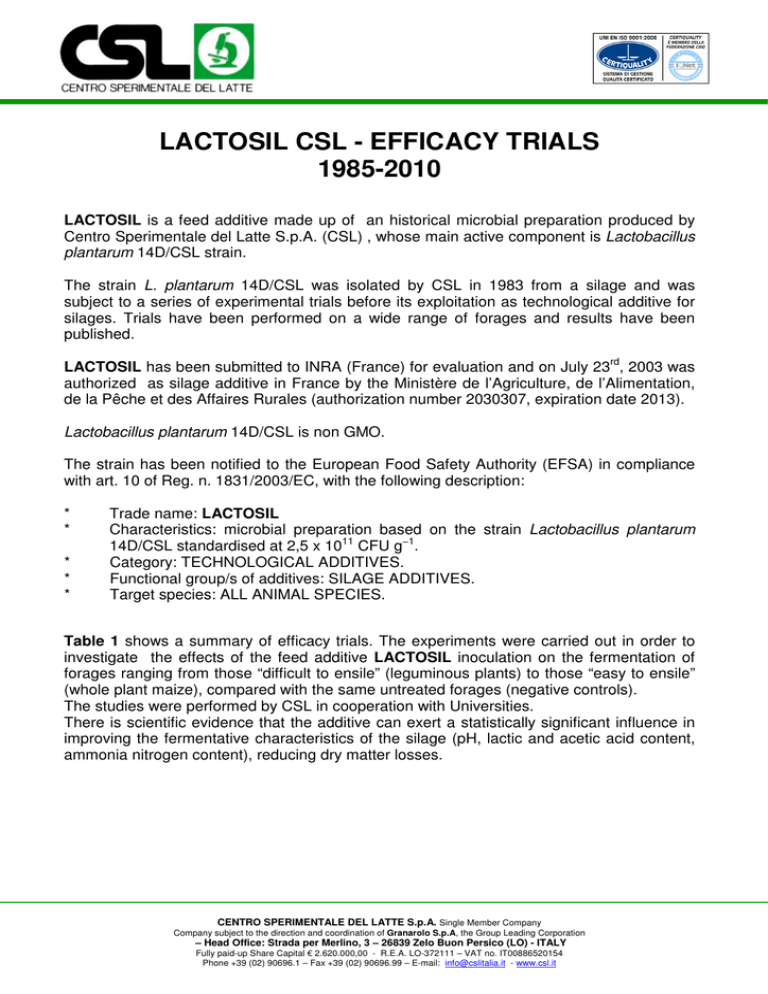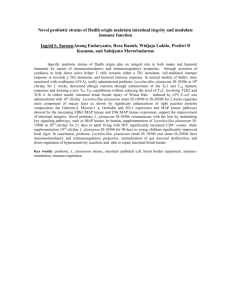lactosil csl - efficacy trials 1985-2010 - CSL
advertisement

LACTOSIL CSL - EFFICACY TRIALS 1985-2010 LACTOSIL is a feed additive made up of an historical microbial preparation produced by Centro Sperimentale del Latte S.p.A. (CSL) , whose main active component is Lactobacillus plantarum 14D/CSL strain. The strain L. plantarum 14D/CSL was isolated by CSL in 1983 from a silage and was subject to a series of experimental trials before its exploitation as technological additive for silages. Trials have been performed on a wide range of forages and results have been published. LACTOSIL has been submitted to INRA (France) for evaluation and on July 23rd, 2003 was authorized as silage additive in France by the Ministère de l’Agriculture, de l’Alimentation, de la Pêche et des Affaires Rurales (authorization number 2030307, expiration date 2013). Lactobacillus plantarum 14D/CSL is non GMO. The strain has been notified to the European Food Safety Authority (EFSA) in compliance with art. 10 of Reg. n. 1831/2003/EC, with the following description: * * * * * Trade name: LACTOSIL Characteristics: microbial preparation based on the strain Lactobacillus plantarum 14D/CSL standardised at 2,5 x 1011 CFU g−1. Category: TECHNOLOGICAL ADDITIVES. Functional group/s of additives: SILAGE ADDITIVES. Target species: ALL ANIMAL SPECIES. Table 1 shows a summary of efficacy trials. The experiments were carried out in order to investigate the effects of the feed additive LACTOSIL inoculation on the fermentation of forages ranging from those “difficult to ensile” (leguminous plants) to those “easy to ensile” (whole plant maize), compared with the same untreated forages (negative controls). The studies were performed by CSL in cooperation with Universities. There is scientific evidence that the additive can exert a statistically significant influence in improving the fermentative characteristics of the silage (pH, lactic and acetic acid content, ammonia nitrogen content), reducing dry matter losses. CENTRO SPERIMENTALE DEL LATTE S.p.A. Single Member Company Company subject to the direction and coordination of Granarolo S.p.A, the Group Leading Corporation – Head Office: Strada per Merlino, 3 – 26839 Zelo Buon Persico (LO) - ITALY Fully paid-up Share Capital € 2.620.000,00 - R.E.A. LO-372111 – VAT no. IT00886520154 Phone +39 (02) 90696.1 – Fax +39 (02) 90696.99 – E-mail: info@cslitalia.it - www.csl.it TABLE 1. LACTOSIL - Lactobacillus plantarum 14D/CSL - SUMMARY OF EFFICACY TRIALS with microsilos. Author(s) Year Forage Calculated application rate Torchio E. et al. (1985) Corn silage > 40% DM 1 x 10 CFU/g forage Efficacy parameters related to the treatment with L. plantarum 14D/CSL 6 Compared to control, improvements related to: - faster pH drop; - lower pH; lactic acid percentage; bacterial counts (prevalence of lactobacilli). 9 Coscia A. et al. Corn silage - 2,0 x 10 Compared to control, improvements related st (1986) 35% DM (1 CFU/kg to: 8 First trial harvest) - 1,2 x 10 - faster pH drop for both the application CFU/kg rates. 9 Coscia A. et al. Corn silage - 1,0 x 10 Compared to control, improvements related nd (1986) > 40% DM (2 CFU/kg to: Second trial harvest) - faster pH drop; - lactic acid percentage. 6 Ferrero A. and Alfalfa 5 x 10 CFU/g Compared to control, improvements related (Medicago sativa) Maggiore T. (1988) forage to: 55% DM - faster pH drop (P < 0,05); - lower pH (P < 0,05); - lactic acid percentage (P < 0,05); - acetic acid percentage (P < 0,05); 6 (*) Andrieu J.P. and Ryegrass 1 x 10 CFU/g Compared to control, improvements related st Rosset W.M. (2000) - 15% DM (1 forage to: harvest) Enclosure n. 5 (p. 67) - DM recovery; nd - 23% DM (2 - lower pH; harvest) - lower N tot.; - lower N-NH3; - better organic acids profile; - reduced alcohols content. 6 Rapetti L. (2010) Corn silage 1 x 10 CFU/g Compared to control, improvements related 33% DM forage to: - lower pH (P < 0,05); - lower temperature (P < 0,05); - N-NH3 percentage (P < 0,01); - lactic acid percentage (P < 0,01; - acetic acid percentage (P < 0,05). (*) Report from INRA. The document is part of « LACTOSIL- DOSSIER D’HOMOLOGATION – 2 ABSTRACTS: trials from 1985 to 2010 1985. Torchio E., Maggiore T., Camaschella P., Laria L. . Indagini preliminari sull’evoluzione della flora microbica nell’insilato di trinciato di mais con aggiunta di batteri lattici. (Preliminary researches on the evolution of the microbial flora in maize silages with added lactic acid bacteria.) L’industria del latte, 1985, 3-4, 127-142. ABSTRACT The aim of the study was the evaluation of some aspects of the effects obtainable by adding a lactic acid bacteria culture (Lactobacillus plantarum 14D/CSL) to a maize silage with more than 40% dry matter . Microsilos with a capacity of about 350 kg forage were used, with 7 replicates per group. The inoculation level was 1,0 x 109 cfu/kg forage. The air was extracted by a vacuum pump and the microsilos were incubated at 25°C in a temperature controlled environment. Incubation times (opening of the microsilos) were: 3, 8, 15, 30, and 60 days. Results. Compared to control, the most significant results related to the treatment were: - Faster pH drop. - Increased total acidity. - Higher percentage of L(+) lactic acid enantiomer versus D(-) enantiomer. - The lactic flora is already prevalent from the 3rd day after ensiling, against the 15th for control. - Lower number of butyric clostridial spores. 1986. Coscia D.., Lavezzari D., Vigezzi P., Torchio E. Valutazione di alcuni parametri qualitativi durante il processo di insilamento del trinciato integrale di mais con aggiunta di lattobacilli. (Evaluation of some qualitative parameters during the ensiling of chopped whole maize with added lactic acid bacteria.) Il latte, 1986, 11, 635-638. ABSTRACT Two experiments were carried out to investigate the efficiency of lactic acid bacteria treatment in chopped whole maize silages of first harvest and second harvest (35% and > 40% dry matter, respectively). As in the previous work of Torchio et. al. (1985), plastic microsilos with a capacity of about 350 kg forage (about 0,5 cubic metres) were used. A freeze dried culture of Lactobacillus plantarum 14D/CSL was used as inoculant with different treatments, i.e.: - For the 1st harvest maize: • control (no treatment); • 2,0 x 109 cfu/kg L. plantarum 14D/CSL, and • 1,25 x 108 cfu/kg L. plantarum 14D/CSL respectively. - For the 2nd harvest maize: • Control; • 1,0 x 109 cfu/kg L. plantarum 14D/CSL, and • 1,0 x 109 cfu/kg L. plantarum 14D/CSL plus urea 50 g/100kg. Incubation times (opening of the microsilos) were: 3, 8, 15, 30, and 60 days. Results. - 1st harvest maize (35% DM): compared to control, the treatments gave a faster pH drop for both the inoculation levels (2,0 x 109 cfu/kg, and 1,25 x 108 cfu/kg) after 3 days, as well after 60 days; - 2nd harvest maize (> 40% DM): compared to control, the treatment with L. plantarum 14D/CSL without urea gave the better results: faster pH drop, higher lactic acid percentage after 3 days of fermentation. However after 60 days the maximum lactic acid percentage was obtained by the combination L. plantarum 14D/CSL and urea. 3 1987. Vismara D., Vigezzi P., Torchio E. Indagini preliminari sull’evoluzione della flora microbica nell’insilato di Lolium multiflorum con aggiunta di lattobacilli. (Preliminary researches on the evolution of the microbial flora in Lolium multiflorum silages with the addition of lactobacilli). Il latte, 1987, 12, 1041-1044. ABSTRACT In this research the influence of the inoculation of lactic acid bacteria (Lactobacillus plantarum 14D/CSL) at two different dosages (1,0 x 109 cfu/kg, and 1,0 x 1010 cfu/kg forage ) on the evolution of the microbial flora during the ensiling process of Lolium multiflorum at earing time has been evaluated. As in the previous work of Torchio et. al. (1985), plastic microsilos with a capacity of about 350 kg forage were used, with or without air extraction, with 7 replicates per group. The microsilos were incubated at 25°C in a temperature controlled environment. Incubation times (opening of the microsilos) were: 3, 8, 30, and 60 days. Results. Compared to control, the most significant results related to the L. plantarum 14D/CSL treatment were: - Faster pH drop (quickness of pH drop was further increased by the higher dosage). - Increased total acidity. - Higher percentage of L(+) lactic acid enantiomer versus D(-) enantiomer. - Lower number of enterobacteria and enterococci (group D Streptococcus). 1988. Ferrero A. and Maggiore T. Indagine preliminare sull’impiego di idrossido di ammonio e di lattobacilli nell’insilamento dell’erba medica. (Preliminary survey into the application of ammonium hydroxide and Lactobacillus inocula on ensiled alfalfa). L’industria del latte, 1988, 1, 35-43. ABSTRACT Alfalfa forage, with 26,9% dry matter (DM) was wilted to 40% DM, 50% DM, and 65% DM, and ensiled in 2 Kg microsilos, with 3 replicates for treatment and incubation time: 7, 21, and 60 days. The 40 and 50% DM samples were treated with: - Ammonium hydroxide (29% NH3): 1 liter/100 kg forage; - Lactobacillus inoculum (L.plantarum 14D/CSL - 250 billions cfu/g): 2 g + 50 g sugar/100 kg forage). The 65% DM samples (haysilage) were not treated. Results. Compared to control and to ammonium hydroxide treatment, the most significant results related to the Lactobacillus plantarum treatment after 60 days ensiling were: - At 40% DM: increased acidity (lactic acid content), although pH was the same in all treatments. - At 55% DM: increased acidity (lactic acid content), lower pH. 4 2000. Andrieu J.-P. and Rosset W.M.. Compte rendu des essais d’efficacité effectués sur l’agent microbiologique d’ensilage « LACTOSIL vert ». (Summary of performance tests conducted on the microbiological starter culture for silage “LACTOSIL vert”). (Dossier d’homologation LACTOSIL 2003, p. 67) ABSTRACT In order to measure the efficacy of this product on the improvement of the quality of silage, three experiments were performed on three sources of ryegrass harvested at different vegetative stages, that is 1st harvest and 2nd harvest. Silages prepared with Lactosil (calculated dosage of about 1,1 x 106 cfu/g fresh forage) were compared to negative (untreated) and positive (treated with formic acid) controls. The experiments were conducted with 9 experimental microsilos of 4 m3 each as follows: A) Experiment with 1st harvest “Texy”ryegrass (about 15% DM and 1,6% soluble sugar): 1) control (no treatment); 2) formic; 3) Lactosil (1,1 x 106 cfu/g fresh forage). B) Experiment with 1st harvest “Fantoom” ryegrass (about 16% DM and 2,1% soluble sugar): 4) control (no treatment); 5) formic acid; 6) Lactosil (1,1 x 106 cfu/g fresh forage). C) Experiment with 2nd harvest “Texy” ryegrass (about 23% DM and 3,1% soluble sugar): 7) control (no treatment); 8) formic acid; 9) Lactosil (1,1 x 106 cfu/g fresh forage). Fermentations lasted about 5 months. Results. On the whole the three experiments demonstrated the efficacy of Lactosil in terms of quick acidification in lactic acid and reduced percentage of acetic acid, lower pH, reduced proteolysis, fall of ammonia (N-NH3) and soluble nitrogen percentages. Compared to control (fresh forage with no treatments), in experiments “A” and “B” both Lactosil and formic acid gave clear and similar quality silage improvements. However in experiment “C” (second harvest ryegrass) the improvements were not so clear as in the previous ones. 2010. Rapetti L.. Evaluation of fermentative parameters of maize silage using Lactobacillus plantarum 14D/CSL (CECT 4528) as feed additive. ABSTRACT The aim of this trial was to determine the variation of pH, temperature, other fermentative parameters and the aerobic stability of maize silage (about 35% DM) in micro-silos using Lactobacillus plantarum 14D/CSL as feed additive according to the EFSA Guidance on technological additives (2008). The essential characteristics of the experiment were: • Feed additive: microbial preparation of freeze-dried L. plantarum 14 D/CSL (CECT 4528) cells standardized at 2.5 x 1011 CFU g-1. • Forage sample (1): whole plant maize at an intermediate dough maturity stage. • Treatments: “C” – negative control; “A” – feed additive at inoculation level of 1.0 x 106 CFU g-1 of fresh forage. • Incubation times: 6 and 90 days. • Replicates: 5 replicates (micro-silos) per incubation time and treatment. According to the EFSA Guidance on technological additives, about 1500 g of fresh forage were ensiled in 2 L micro-silos with lid seal and bleed valve. The average packing density obtained in the present trial was 750 kg/m3, equivalent to 246 kg DM/m3. On the bottom of the micro-silos inert material was added, separated through a filter paper in order to absorb the effluent. The micro-silos were then incubated in a temperature controlled environment at 20°C.After 6 and 90 days of incubation 5 micro-silos for each treatment were opened for analyzing the silages. 5 The aerobic stability evaluation was performed on 10 micro-silos (2 Treatments x 5 Replicates) after 90 days of incubation. The micro-silos were opened at 90 d of incubation and the temperature was measured daily up to the seventh days (T0-T7) since the opening and then at 12th and 13th days. Results. The addition of the additive resulted effective in improving the fermentative characteristics of the silage. Particularly, at 90 days of ensiling, the samples inoculated with L. plantarum 14D/CSL in comparison to the untreated Control silage had lower ammonia nitrogen (-12%) and higher lactic (+85%) and acetic acids (+24%). The aerobic stability study did not show any difference due to the treatment applied on the forage. 6

